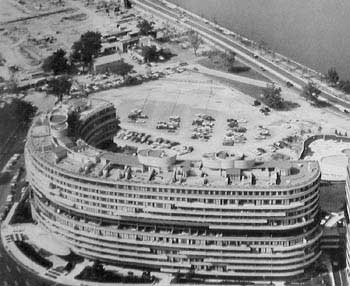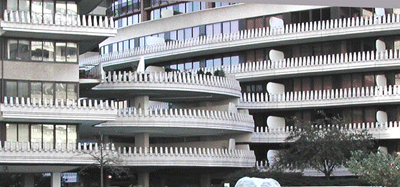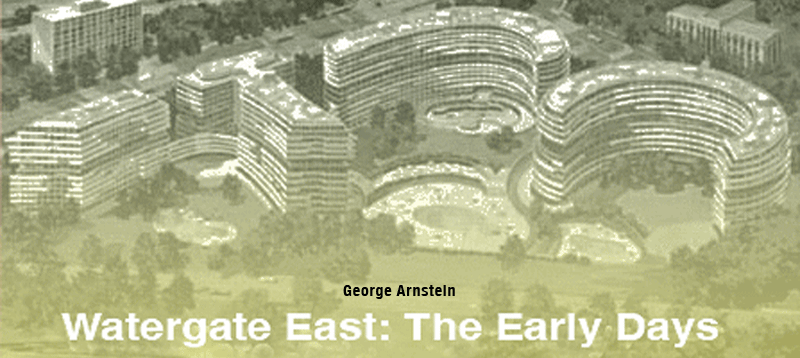|
|
Part 1: At First Glance
In the process of cleaning out old files, I found a receipt for two keys to the front door of our apartment, dated November 24, 1965. This agrees with my recollection that we - my late wife, Sherry, and I -- moved in over Thanksgiving. Ediltecnico S.p.A was identified as authorized agent for the owner which also operated as Watergate Improvement Associates.
The sponsor retained an Italian architect, Luigi Moretti, plus an affiliated domestic firm [SOM], but the Italian ties were visible to the point where the enterprise was known as Vatican City West, reflecting the minority interest of the Vatican. And I certainly recall how Joe (Guiseppe) Cecchi, a leading light of the undertaking, was among the very early residents at the South end of the second floor.
We had been invited to move by early November, but my wife wisely suggested that we ought to wait a month because the building looked unfinished.
Unfinished it was: While the structure was complete, the top floors were unfinished; the hallways and lobby were uninviting. Just before our move-in we were invited for a walk-through. (Another item from my notes: The original drapes were ROVANA, made by Dow Chemical, nonflammable, rot and mildew resistant; dry clean. I just found them in my basement locker which I am also purging.)
We noted several deficiencies, and I then asked to see our parking space. The awkward reply was that the sponsor did not yet have an occupancy permit for the garage, that they would provide valet parking, and -- very important -- that we would have first choice of any spot we wanted, other than a dozen reserved for the expensive penthouses. And that is how it came to pass that I own an unusually wide space, because my wife wanted easy access and exit, and we often used it to accommodate a second [compact] car. The very first summer, the son of a neighbor, home from college, parked his MG there. The neighbors, Mortimer and Mickey Janis became friends and I am still in touch with Mickey, a widow who moved to Florida and last year returned to DC.
What was for a short time the manager's office in the South wing, at first was a package room as well as a place to leave and pick up dry cleaning. Our lobbies were not completed and could not handle these items. The first issue of our in-house newsletter, The Watergate Post, was dated May 6, 1966: “There are by now well over 100 families."
|
Approximately 20 more families take occupancy each week... the Builder has not been able to handle problems in occupied apartments as promptly as he, we or you would like.” Backups on entering the garage were frequent because the “toll booth” for the commercial garage was located almost at street level. Result: We, the residents, had to wait while “outsiders” fumbled for money or directions.
There was no neon sign to show whether the commercial space was “Full” with similar results, something we still encounter sometimes when drivers don't believe in signs.
As for the cab stand, original plans called for the installation of a call light, but the plans were “mislaid,” to be revived months later after our request. There had been management memos like the one issued Feb 26, 1966. It forecast a liquor store by late April, Valet for May, Riggs Bank in May, People”s Drugs (now CVS) in June, Safeway late July, Pastry shop in June, and a restaurant for the “latter part of year.” My notes show that the Barber shop opened Summer 1966, Safeway October 5, 1966.
Strangely enough, I cannot recall where the restaurant was or was to be located, since the hotel was built much later. We used to have an unobstructed view up the river, clear to Key Bridge. Fortunately the sponsor had clearly disclosed that we were Stage 1, to be followed by others: South (with a confusing name since we have a South wing), originally intended as all apartments, the Office building and hotel, and West. Even today, many city maps show South as a solid horseshoe despite the split into an office and an apartment building.
“We are ...negotiating leases for several ... stores, including travel agency, jeweler, florist, savings and loan, haberdashery and ladies apparel.” Indeed the jeweler, the S&L and the haberdasher came and went, as did Colette, a ladies boutique. Many a weekend I explored our building, the unfinished top floors, and the nearly ready storage areas and the promised shopping. We were a rental during the first few months, mostly because a cooperative, by law had to have x percent owners. We reached the magic number so that on March 28, 1996 the sponsor called for the first annual meeting to be held April 18 1966 at 8 pm in the auditorium of the People's Life Insurance Building (today the Saudi embassy.)
|
| Part 2: Should Clerks Wear Tails?
We were renters during the first few months, mostly because a cooperative, by law had to reach a certain percent of owners. We reached the magic number so that on March 28, 1965 the sponsor issued the call for the first annual meeting to be held April 18 1965 at 8 pm in the auditorium of the People's Life Insurance Building (today the Saudi embassy.)
The sponsor had many names. This specific memo was signed by Harold Lewis, as President of Riverview Realty Cooperation,
A “Notice” was signed by Joseph Lewis, identified as Secretary of Watergate East Inc. The report of the president of Watergate East Inc. was signed by Royce Ward who, in fact, worked for the sponsor.
Quite properly he reported: “on March 29th [1965] the formal transfer of title between Watergate Improvement Associates and Watergate East will be accomplished.... The documents will be bound, and a complete set made available to Watergate East for permanent use.”
I can't help but note that Ward, being “our” president, also said “The public areas [i.e. lobbies etc.] should be completed “in the near future.... The fountains should soon be in operation again.... The swimming pool will be ready in time for the season.” My own notes mention: “Air cond. May 1" presumably discussed at the meeting.

|
The initial Board of Directors was hand picked [who else would or could?] by the sponsor, succeeded by duly elected members which included Mary Garner, elected secretary, who, until recently, lived with her sister, Agnes Martin. Agnes passed away in February. I was elected and reelected as a director in 1971 and served as treasurer. My second stint was in 1994. Recently I served on one committee, chaired another, and resigned when we had our annual changing of the guard in early April.
This is a good place to recall the rather precious [in my opinion] advertising campaign of the sponsor, the Italian company which had the vision to make something of a site which had been the gas works, more or less at the edge of the city.
I recall how the AAUW moved its headquarters on Farragut square to their own newly built home on Virginia Ave (the corner where Western Presbyterian now stands); I thought it was far away from my office, then at 16 & M NW.
Watergate was advertised as a sophisticated, expensive (because they emphasized the penthouses), elegant place to live, so much so that one resident urged that our desk clerks were to wear tails. She did not prevail. Of course the sponsor insisted that we enjoy Muzak, the elevator music piped through the hallways via built-in loudspeakers.
The reality was less sophisticated. The disputes between our Board and the sponsor reached a point where an early president of the cooperative said: “They seem to have forgotten that they no longer own it; we do.” There was a roof that leaked and was fixed at major expense to the sponsor, but only after a serious threat of litigation (by a resident who was a senior partner in a leading law firm.)
After many a rainstorm, dirt poured from the adjacent empty lot (now Watergate South.) into our garage. A photograph of the lot is shown below and also hangs in the North B3 elevator lobby.
Life magazine for Aug 8, 1969 (photograph above) had an illustrated feature story which included Watergate West. The heading sets the tone: “In Washington it used to be Georgetown; now its Watergate.” It enumerated, confined to Nixon's GOP, three Cabinet members, two senators, Nixon's chief of protocol and more than a dozen White House aids.”
In fact we had more of the above, thus acquired a Republican reputation, to the neglect of a Democratic minority.
Some personal items:
We were disappointed in our guest bathroom sink. We wrote to the sponsor, saying that the display in the sales office had shown something much nicer. After a delay they fixed it.
We thought the trash chutes too noisy, met with some resistance, then got them insulated.
The “proof” was that a neighbor, also awakened by a heavy load at 2 a.m, got up to investigate, only to encounter me, headed for the trash room on the same mission. We prevailed. After all, we had been promised good sound proofing (which continues to be quite good to this day.)
|
Part IV
Watergate balconies link buildings to one another and to the PUD
Back in the early 1960's, the Watergate architecture was adapted in some unusual ways to bring the developer's original concepts in sync with the city's PUD requirements. This resulted in building balconies which differ from the overall design from their counterparts when armed with a bit of history you can see today.
All of the buildings in the Watergate complex are connected, not only by a common heating plant, but by visible connections above ground, a kind of connective tissue which ties together balconies at the end of every building. The linkages allow car passage at ground level, like the entrance to the hotel, front and back. The “bridges” connect floors 2, 3 and 4 which means that those apartments at the end of the buildings have rather generous balconies, more like private porches. Owners of several of these, with permission of the Board, have made modifications so that they have an additional room.
What's the explanation for these “bridges”? Here we go back to the original concept

|
of a city within a city, the original PUD (the first one in D.C.), a zoning device which treats the complex as a single entity and, not incidentally, allows the various buildings to occupy the land on a unified (unit) basis, rather than to force every building separately to allow a required amount of open space. In short, the total open space is the same, possibly a bit more generous, distributed differently, as long as there is only a single building.
This seems to conflict with our separate buildings, separately incorporated. Indeed, but the four connecting balconies meet the zoning requirement by linking the five buildings into a single unit (the PUD). Apparently four stories high is the required minimum, and thus we have, at least technically, a single Watergate building.
The historical particulars of these balconies have brought advantages and disadvantages to the residents whose apartment balconies serve as between building connectors. Three of these owners, with permission of the Board, have made modifications so that they have an additional room. A lovely amenity.
But, the balconies have also brought their owners closer to the occasionally intrusive noises of vehicles directly below them, including car alarms, and VIP cars assigned to those drivers clutter up an area which was intended to be reasonably clear of cars.
In fact, the sponsor, the Italian developer, originally promised residents that there would be no surface parking, that parking would be restricted to the spaces at the B-2 and B-3 levels.
Doormen of each residential unit fight to protect the entry roads free of parked vars. Earlier owners of the hotel installed the red phone booth from Britain, prevent parking, blocked off the space right outside some hotel windows, and confined their entrance to the loading and unloading of guests and luggage. But, over the years with the growth vehicular traffic, the hotel has become lax and has allows an accumulation of parked cars with their accompanying noise. Not all balconies yield the same pleasures.
HOME
|
|
|
|
